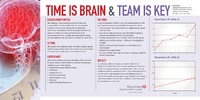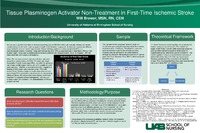Time is brain, team is key
View File(s)
- Author(s)
- Details
-
Chantal Howard, MSN, RN, CEN, chhoward@wakemed.org; Leighann Flanagan, RN, CEN
Visitor Statistics
Visits vs Downloads
Visitors - World Map
Top Visiting Countries
| Country | Visits |
|---|
Top Visiting Cities
| City | Visits |
|---|
Visits (last 6 months)
Downloads (last 6 months)
Popular Works for Howard, Chantal by View
| Title | Page Views |
|---|
Popular Works for Howard, Chantal by Download
| Title | Downloads |
|---|
View Citations
Citations
Purpose: The American Heart Association has set 60 minutes as the goal for “door to needle” time for the treatment of Acute Ischemic Stroke. The objective of this quality assurance project was to significantly reduce the 120 minute ‘processing’ time for stroke patients from time of arrival in a Level I Trauma Center to the administration of t-PA.
Design: Quality assurance project using a multidisciplinary team approach.
Setting: 870-bed urban healthcare system and Level One Trauma Center; Primary Stroke Center.
Participants: In order to identify and problem-solve delays in care, we enlisted the participation of every internal AND external entity that impacted the care of our stroke patients. These included the local area Emergency Medical Systems, Laboratory, Radiology, Clinical Administrator (House Supervisor), Rapid Response Team, Pharmacy and, of course, all staff in the Adult Emergency Department (N=~250).
Methods: Once it was determined that a change needed to occur, our ED Leadership team scrutinized each step in the process-- from initiation of the 911 call in the community to the administration of t-PA. With the assistance of ED staff, time guzzlers were identified and strategies proposed to reduce them. Internal and external partners were identified; champions included the EMS Medical Director and the Director of Pathology. Inter-departmental barriers were discussed and reduced through collaborative problem-solving; policies and procedures were written, education was created and disseminated and supplies were standardized.
Results/Outcomes: Results have been remarkable primarily because of the multidisciplinary team buy-in to the new process. For example, the pre-hospital (EMS) lab draw has helped reduced our lab turnaround time from 43 minutes to 31. Keeping the patient on the EMS stretcher from arrival in the ED to CT has reduced door to CT time from 19 to 11 minutes. Before the initiation of the project, the door to treatment with t-PA was 120 minutes. This was reduced to 40 minutes within the first month and sustained at less than 60 minutes for six months after its commencement. (Additional results will be available on the poster at the conference.)
Implications: Key to our success was creating a coordinated, choreographed process that actively sought the assistance of any discipline or department that impacted the care of our Acute Ischemic Stroke patient. The outcomes speak for themselves; as does our subsequent recognition on the American Heart Association’s Target Stroke Honor Roll.
2014 ENA Leadership Conference Theme: Safe Practice, Safe Care. Held at the Phoenix Convention Center
Items submitted to a conference/event were evaluated/peer-reviewed at the time of abstract submission to the event. No other peer-review was provided prior to submission to the Henderson Repository, unless otherwise noted.
| Type | Poster |
| Acquisition | Proxy-submission |
| Review Type | Abstract Review Only: Reviewed by Event Host |
| Format | Text-based Document |
| Evidence Level | N/A |
| Research Approach | N/A |
| Keywords | Treatment Reduction Time; Strokes; t-PA Administration |
| Name | 2014 ENA Leadership Conference |
| Host | Emergency Nurses Association |
| Location | Phoenix, Arizona, USA |
| Date | 2014 |
All rights reserved by the author(s) and/or publisher(s) listed in this item record unless relinquished in whole or part by a rights notation or a Creative Commons License present in this item record.
All permission requests should be directed accordingly and not to the Sigma Repository.
All submitting authors or publishers have affirmed that when using material in their work where they do not own copyright, they have obtained permission of the copyright holder prior to submission and the rights holder has been acknowledged as necessary.
Related items
Showing items related by title, author, creator and subjects.
-
As simple as 1-2-3: Recruit, respect, retain
Howard, Chantal; Flanagan, Leighann; Exterkamp, Laura (2014-08-04)Purpose: Poor nurse retention incurs an enormous and often unrecognized cost to an organization which can be measured in more than dollars. Barriers to staff retention include personal life changes, colleague callouts, and ... -
Nursing leadership through the time of COVID-19
Catton, Howard; Dai, Hung-Da (David); Gitembagara, Andre; Iro, Elizabeth; Jakab-Hall, Charlotte; James, Iris; Kenna, Rachel; Kumar, T. Dileep; Leme, Ana Julia; Madigan, Elizabeth A.; Moore, Martie; Nandili, Mary; Stilwell, Barbara; Waterman, C. Joannah (Sigma Theta Tau International, 2020-09-24)Just five months following the State of the World’s Nursing Report release, nurses and nursing organizations are dealing with the global game changer that is COVID-19. The pandemic has impacted nurses, nursing ... -
Tissue plasminogen activator non-treatment in first-time ischemic stroke
Brewer, Will E. (2015-01-15)Session presented on Friday, September 26, 2014: The purpose of this proposed qualitative research study is to evaluate physicians attitudes toward tPA and how their attitudes negate its use in first-time ischemic stroke ... -
Innovative collaborative nurse educator team: Scaffolding for successful student outcomes
Gallegos, Belinda; Keesee, Lea; Clark, Rebecca; Morgan, Venisa R.; Gibson, Erin; Stansell, Priscilla; Baba, David; Howard, Christy T.; Winner, Marnette; Paris, Donna; Casaus, Deborah; Ochs, Nancy; Franco, Hollis; Guest, Heather; Alvarez, Stacie; Boothe, Amy L.Nursing faculty from a multi-site health sciences center describe their innovative, collaborative approaches to foster a positive work environment that cultivates and scaffolds student success, critical thinking skills, ... -
Teleneurology: Streamlining care of stroke patients in emergency rooms
McPherson, Benjamin; Carson, Carri; Littlefield, Debra; Bernatene, Kelly; Dyson, Jessica; Wells, Leighann; Zink, Joseph (2017-12-05)Session A presented Thursday, September 14, 2017 Purpose: Patients in Emergency Departments (EDs) that are having strokes now have an opportunity to receive endovascular therapy(EVT) for improved outcomes.1,2,3 Unfortunately, ...





